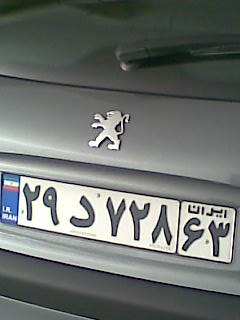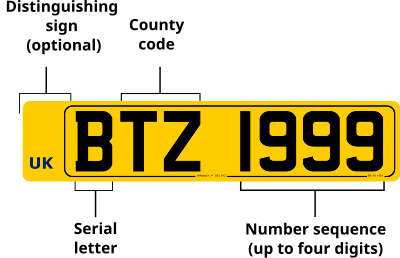
The Driver and Vehicle Licensing Agency is the organisation of the British government responsible for maintaining a database of drivers in Great Britain and a database of vehicles for the entire United Kingdom. Its counterpart for drivers in Northern Ireland is the Driver and Vehicle Agency. The agency issues driving licences, organises collection of vehicle excise duty and sells personalised registrations.

A vehicle registration plate, also known as a number plate or license plate or licence plate, is a metal or plastic plate attached to a motor vehicle or trailer for official identification purposes. All countries require registration plates for road vehicles such as cars, trucks, and motorcycles. Whether they are required for other vehicles, such as bicycles, boats, or tractors, may vary by jurisdiction. The registration identifier is a numeric or alphanumeric ID that uniquely identifies the vehicle or vehicle owner within the issuing region's vehicle register. In some countries, the identifier is unique within the entire country, while in others it is unique within a state or province. Whether the identifier is associated with a vehicle or a person also varies by issuing agency. There are also electronic license plates.
In Ireland, commonly referred to as the Republic of Ireland, vehicle registration plates are the visual indications of motor vehicle registration – officially termed "index marks" – which it has been mandatory since 1903 to display on most motor vehicles used on public roads in Ireland. The alphanumeric marks themselves are issued by the local authority in which a vehicle is first registered.

The country in which a motor vehicle's vehicle registration plate was issued may be indicated by an international vehicle registration code, also called Vehicle Registration Identification code or VRI code, formerly known as an International Registration Letter or International Circulation Mark. It is referred to as the Distinguishing sign of the State of registration in the Geneva Convention on Road Traffic of 1949 and the Vienna Convention on Road Traffic of 1968.
Australian vehicle registration plates or number plates are issued by state, territory, and Commonwealth governments, and the armed forces of Australia. The plates are associated with a vehicle and are generally intended to last for the time the vehicle remains registered in the state, though as they become unreadable they may be remade with like for like replacement. Motor vehicle registration in Australia can be renewed monthly, quarterly, half yearly or annually depending on the state or territory where the vehicle is registered.
The most common format for vehicle registration plates in Romania consists of black letters on white background in the format CC 12 ABC, where CC is a two letter county code, 12 is a two digit group, and ABC is a three letter group. For Bucharest, the format is B 12 ABC or B 123 ABC, where B is code for Bucharest city, 12 and 123 is a two or three digit group, and ABC is a three letter group. The left side of the plate bears a blue vertical strip displaying the 12 stars of the European Union and the country code of Romania (RO). Between 1992-2007 the band featured the Romanian flag instead of the 12 stars. All lettering comes from the Latin alphabet.
A vanity plate or personalized plate ; prestige plate, private number plate, cherished plate or personalised registration ; personalised plate or custom plate is a special type of vehicle registration plate on an automobile or other vehicle. The owner of the vehicle pays extra money to have their own choice of numbers or letters, usually portraying a recognizable phrase, slogan, or abbreviation, on their plate. Sales of vanity plates are often a significant source of revenue for North American provincial and state licensing agencies. In some jurisdictions, such as British Columbia, vanity plates have a different color scheme and design.
Austrian car number plates are mandatory vehicle registration plates displaying the registration mark of motor vehicles in Austria. They are used to verify street legality, proof of a valid liability insurance and to identify and recognise the vehicle.
A vehicle registration plate, also known as a number plate, license plate or licence plate, is a metal or plastic plate or plates attached to a motor vehicle or trailer for official identification purposes. The registration identifier is a numeric or alphanumeric code that uniquely identifies the vehicle within the issuing authority's database. In Europe most countries have adopted a format for registration plates that satisfies the requirements in the Vienna Convention on Road Traffic, which states that cross-border vehicles must display a distinguishing code for the country of registration on the rear of the vehicle. This sign may be an oval sticker placed separately from the registration plate, or may be incorporated into the plate. When the distinguishing sign is incorporated into the registration plate, it must also appear on the front plate of the vehicle, and may be supplemented with the flag or emblem of the national state, or the emblem of the regional economic integration organisation to which the country belongs. An example of such format is the common EU format, with the EU flag above the country code issued in EU member states.
The Vehicle register in the United Kingdom is a database of motor vehicles. It is a legal requirement in the UK for most types of motor vehicle to be registered if they are to be used on the public road.

Vehicle registration plates in Denmark normally have two letters and five digits and are issued by authorities. Plates can be obtained at authorized car dealers, vehicle inspection stations or official registration centers. The combination is simply a serial and has no connection with a geographic location, but the digits have number series based on vehicle type.

Vehicle registration plates of Gibraltar are similar to those of the United Kingdom, with the same colours and typeface, similar to the common EU format. Vehicle registration plates, usually called 'number plates', include the international vehicle registration code for Gibraltar, 'GBZ'. GBG is used for Guernsey.

In the United Kingdom, a driving licence is the official document which authorises its holder to operate motor vehicles on highways and other public roads. It is administered in England, Scotland and Wales by the Driver and Vehicle Licensing Agency (DVLA) and in Northern Ireland by the Driver & Vehicle Agency (DVA). A driving licence is required in England, Scotland, and Wales for any person driving a vehicle on any highway or other "road", as defined in s.192 Road Traffic Act 1988, irrespective of the ownership of the land over which the road passes. Similar requirements apply in Northern Ireland under the Road Traffic Order 1981.

Vehicle registration plates, commonly referred to as number plates, are the mandatory alphanumeric plates used to display the registration mark of a vehicle in Jersey. Vehicle registration marks are issued in Jersey by Driver and Vehicle Standards, a Government of Jersey department, and are entirely different from those issued in other jurisdictions.

The Convention on Road Traffic, commonly known as the Geneva Convention on Road Traffic, is an international treaty promoting the development and safety of international road traffic by establishing certain uniform rules among the contracting parties. The convention addresses minimum mechanical and safety equipment needed to be on board and defines an identification mark to identify the origin of the vehicle. The Convention was prepared and opened for signature by the United Nations Conference on Road and Motor Transport held at Geneva from 23 August to 19 September 1949. It came into force on 26 March 1952. This conference also produced the Protocol on Road Signs and Signals.

Iranian license plates have had European standard dimensions since 2005. Each province in Iran has multiple unique, two-digit codes that are included at the right end of the license plates in a distinguished square outline, above which the word ایران or "Iran" has been written. A province's license plates will not be issued with a new code unless all possible combinations with the old code have been issued. In Tehran, the first code to be issued for the province was code 11, and subsequent codes all increased by 11 as well Ever since code 99 was fully issued, the new codes for Tehran have started from 10 and subsequently increased by 10. Most province codes increased by 10 based on the first code issued for their province. Khuzestan Province, for example, has been allocated codes 24 and 14, and code 24 will not be used before code 14 is fully issued. However, as codes started getting exhausted, numbers and letters have been assigned more liberally and without following this rule of thumb anymore

United Kingdom aircraft registration is a register and means of identification for British owned and operated commercial and private aircraft, they are identified by registration letters starting with the prefix G-.
Vehicle registration plates are the alphanumeric plates used to display the registration mark of a vehicle, and have existed in the United Kingdom since 1904. It is compulsory for motor vehicles used on public roads to display vehicle registration plates, with the exception of vehicles of the reigning monarch used on official business.

Vehicle registration plates are issued by the Driver Vehicle License Authority, the body responsible for vehicle registration in Ghana. The plates indicate the region where the vehicles bearing them were registered. Ghana has no restrictions on the use of number plates in the various regions, for example, a vehicle registered in the Ashanti Region can be used in the Brong-Ahafo Region.


















